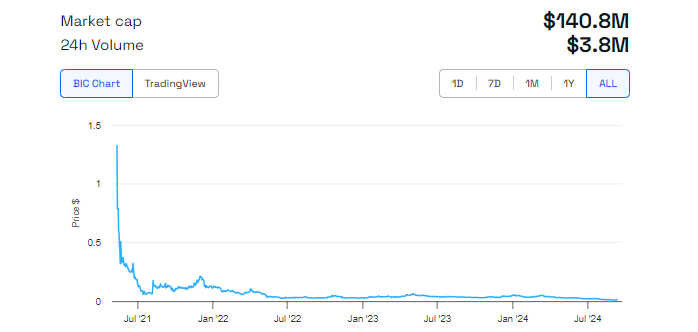Casper is a unique layer-1 solution designed to empower developers and enterprises. This guide explores the details behind the Casper Network, including the native casper crypto (CSPR), its concept, functionality, and impact in the web3 space.
KEY TAKEAWAYS
• Casper Network is a layer-1 blockchain designed to be enterprise focused.
• The Casper Network uses a unique proof-of-stake mechanism called Highway, that emphasizes security and flexibility.
• Casper’s native token, CSPR, incentivizes staking and network participation to promote utility.
• Casper Network stands out for its energy efficiency, upgradeable smart contracts, and collaborations with major organizations.
What is Casper Network?
Casper is a layer-1 blockchain project that offers a user-friendly, accessible, and secure platform for businesses and developers seeking to create blockchain applications.
Contrary to other blockchains that mandate rigorous training and the use of niche programming languages, Casper is intentionally designed to be accessible to a broader range of developers. By doing so, it ensures that millions of developers can quickly and easily begin working with the platform.
Built on the Casper CBC specification, Casper integrates designs conceptualized by Ethereum developers. Amidst many layer-1 projects, Casper uniquely hails as an “enterprise-grade focused” blockchain. Specifically crafted for business applications, it seamlessly distinguishes itself from networks geared towards retail, such as art-based NFTs and DeFi protocols.
History of Casper Network
Casper’s journey traces back to early research focused on scalability issues that Ethereum faced in 2017. This research was led by Vlad Zamfir, a prominent figure at the Ethereum Foundation.
In late 2018, Vlad Zamfir, along with Casper Labs co-founders Medha Parlikar and Renée Manohar, began collaborating on developing a new blockchain using the CBC proof-of-stake research.
While Casper Labs had already initiated work on the code base for the Casper Network, the research agreement only became official in February 2019. Differences in research direction eventually led to the termination of the agreement in September 2019.
Casper Labs continued research on its CBC specification and blockchain adoption and eventually published a draft of the Highway protocol. This draft formed the backbone of the Casper Network we know today.
Vlad Zamfir later filed a lawsuit against Casper Labs in 2021, alleging that the company misled investors into thinking they were investing in Ethereum rather than the Casper protocol. The court denied Vlad Zamfir’s motions, marking a win for the Casper Labs team. The Casper network went live on Mar. 31, 2021.
Decoding the functionality of Casper Network

Casper Network uses a proof-of-stake mechanism akin to many layer-1 networks and uniquely incorporates a consensus mechanism known as CBC Casper. This approach has drawn notable attention, even earning an endorsement from Ethereum’s co-founder, Vitalik Buterin.
Although CBC Casper isn’t directly affiliated with Casper Network, it inspires its “Highway consensus.” This enhanced version prioritizes network security and Byzantine fault tolerance, which is crucial for blockchain systems.
Casper’s Highway consensus protocol provides a unique approach to achieving consensus. The protocol focuses on two key aspects: safety and liveness.
Safety in the context of Casper means that the network will not make inconsistent decisions. In other words, it ensures that the network’s decisions are coherent and aligned with its rules. Liveness, conversely, refers to the protocol’s ability to stay active and eventually make a decision, reaching finality.
Casper’s approach to finality is where it truly stands out. In traditional Byzantine fault tolerance systems, finality is achieved when two-thirds of the network validators act honestly. However, Casper’s Highway consensus takes a more dynamic approach.
The more honest validators there are, the higher the finality rate. This means that during periods when more than two-thirds of the network validators are acting honestly, Casper’s finality is much stronger and more robust.
Furthermore, Highway consensus allows each validator node to set its own threshold for finality. This flexibility allows different nodes to play various roles within the Casper ecosystem.
For example, some nodes can handle smaller, basic transactions with lower thresholds, while others can focus on validating larger, more complex transactions that require higher safety levels.
What makes the Casper network unique?
Casper Network boasts several unique features that set it apart from other blockchain projects. Some of its standout features include:
- Energy efficiency: Reports indicate that Casper is 136,000 percent more energy-efficient than other networks. Although Ethereum has enhanced its energy efficiency, Casper holds a notable advantage in this aspect.
- Easy-to-use: Casper provides familiar tools, open architectures, and expert support, making it simple to develop with. The use of WebAssembly and the Rust programming language further simplifies the development path for enterprises and development teams.
- Enterprise-grade: Casper is optimized for enterprises and projects of all sizes, providing flexibility in choosing a public, private, or hybrid network. Its modularity, compatibility with existing tech stacks, and the programmability of Rust make it a suitable choice for enterprises.
- Scalability: The network achieves scalability through a proof-of-stake (PoS) architecture, which will enable sharding, a database scaling solution. Sharding involves breaking the blockchain into smaller, manageable parts, increasing its capacity to process transactions and smart contracts efficiently.
- Upgradable smart contracts: Casper uniquely allows modification of smart contracts after deployment, unlike other blockchains. This flexibility, which is valuable for enterprises seeking to update features or fix bugs while maintaining high security, sets Casper apart.
- Low and predictable costs: The layer offers transparency and predictable gas fees, making it cost-effective for users and developers. Its upgradable infrastructure ensures enduring and equitable innovation.
- Collaborations: Casper has established collaborations with significant organizations, including Blockchain Service Network (BSN), IBM, World Economic Forum (WEF), BlockV, and Hyperledger. Its collaboration with IBM aims to enable cross-chain transactions between private permissioned networks and the Casper blockchain, enhancing interoperability.
Casper (CSPR) crypto
The Casper network uses CSPR crypto, its native coin, to reward validators who participate in the consensus mechanism on its PoS blockchain. It also serves as the currency for network fees, enabling users to perform on-chain actions.
Casper Labs has partnered with CoinList for the initial public token sale of CSPR, which is available to participants in supported jurisdictions. Regulatory considerations exclude residents of the U.S., China, and Canada from participating in this sale.

It is important to note that CSPR doesn’t have a total supply cap. Two main reasons drive this unique approach. First, inflation incentivizes users to utilize their CSPR for staking and network functions actively. Second, Casper Network imposes fixed fees, such as 0.1 CSPR and a minimum transaction size of 2.5 CSPR, making the coin’s value utility-driven.
Tokenomics of CSPR

CSPR crypto plays a vital role in the network’s ecosystem. CSPR is used for staking, securing the network, and paying transaction fees. The annual inflation rate for CSPR is 8%, but staking provides an 8% annual percentage yield (APY), effectively offsetting the inflation rate for stakers.
Transaction fees on the Casper Network are set at 0.1 CSPR per transaction, with a minimum transaction value of 2.5 CSRP. This fee structure encourages users to actively use their CSPR rather than hoarding it, aligning with the project’s focus on utility.
“After years of diving deep into the crypto space, $QNT, $CSPR, and $TAO stand out as my top three projects. The sheer number of dedicated developers, the unparalleled quality, influential backers behind the scenes, and tangible real-world use cases make them unbeatable. Keep an eye on these CryptoGems. The sun is rising on these projects.”
@QntoshiNakamoto: Twitter
Casper does not have a total supply cap, as its value comes from its utility in the network. This approach incentivizes users to use CSPR for staking and other functions. It’s a departure from the scarcity-based model seen in cryptocurrencies like Bitcoin, emphasizing the importance of network utility.
Distribution of casper crypto
As of the launch of the Casper mainnet, the total circulation supply of CSPR was 10 billion. Due to the 8% annual inflation rate, it has grown to approximately 11.3 billion CSPR, with around 12 billion CSPR in circulation as of July 2025.
Where to store casper crypto?

Casper wallets act as gateways to the Casper Network, allowing users to stake, transact, and interact with the blockchain. A good CSPR wallet will provide a user-friendly interface for managing CSPR crypto and participating in network activity, such as signing transactions and connecting to DApps.
Selecting the ideal Casper Wallet depends on your individual objectives. If you opt for a non-custodial wallet, your initial consideration should be whether you prefer a hot or cold wallet. Common choices for a hot wallet among CSPR enthusiasts encompass platforms like Casperwallet.io and Simple Wallet, while those leaning towards a cold wallet often favor Ledger or Trezor.
| Wallet | Type | Custody | Staking |
|---|---|---|---|
| Casperwallet | Mobile | Non-custodial | Yes |
| Simple Wallet | Browser extension | Non-custodial | Yes |
| Ledger | Hardware | Non-custodial | Yes |
| Trezor | Hardware | Non-custodial | No |
What lies ahead for Casper?
Casper Network is a promising project that has carved a unique path in the blockchain space. Its roots in Ethereum’s research, combined with an innovative consensus mechanism, set it apart. Casper Labs is proactively expanding its enterprise deployments and engaging in discussions with numerous Fortune 500 companies. As such, the network’s promise to maintain a “future-proof blockchain enabling long-term solutions to real-world challenges” seems ambitious but not impossible.
Disclaimer: This article is for informational purposes only and should not be considered financial advice. Investing in CSPR or any other crypto carries significant risk.
Frequently asked questions
What does Casper network do?
What network does casper use?
Is Casper Network a good investment?
Is Casper on the Ethereum network?
Who is behind the Casper Network?
Is Casper future-proof?
Can CSPR reach $10?
Disclaimer
In line with the Trust Project guidelines, the educational content on this website is offered in good faith and for general information purposes only. BeInCrypto prioritizes providing high-quality information, taking the time to research and create informative content for readers. While partners may reward the company with commissions for placements in articles, these commissions do not influence the unbiased, honest, and helpful content creation process. Any action taken by the reader based on this information is strictly at their own risk. Please note that our Terms and Conditions, Privacy Policy, and Disclaimers have been updated.




